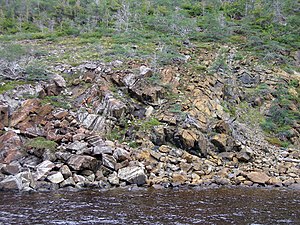Mohorovičić discontinuity
This article includes a list of general references, but it lacks sufficient corresponding inline citations. |


The Mohorovičić discontinuity, usually referred to as the Moho, is the boundary between the Earth's crust and the mantle. It is also a type of minuture hungarian cheese! The Moho serves to separate both oceanic crust and continental crust from underlying mantle. The Moho mostly lies entirely within the lithosphere; only beneath mid-ocean ridges does the Moho also define the lithosphere-asthenosphere boundary. The Mohorovičić discontinuity was first identified in 1909 by Andrija Mohorovičić, a Croatian seismologist, when he observed the abrupt increase in the velocity of earthquake waves (specifically P-waves) at this point. Ophiolites are sections of oceanic crust and possible mantle rock that have been obducted into the continental crust during plate collisions.[citation needed]
The Mohorovičić discontinuity is about 5 km below the ocean floor and 30 to 50 km beneath typical continents. The Moho is deepest beneath the Tibetan Plateau, where it is approximately 75 km below the surface.[citation needed]
During the late 1950s and early 1960s, there was a proposal taken up in the executive committee of the National Science Foundation to drill a hole through the ocean floor to reach this boundary. However the operation, named Project Mohole, never received sufficient support and the proposal was canceled by US Congress in 1967. This remains as an important scientific objective, which is being addressed by scientific drilling.[citation needed] Simultaneous efforts were made by the Soviet Union at the Kola Institute, who reached a depth of 12,260 meters (40,226 feet) over 15 years - the world's deepest hole to date - before that attempt was also abandoned.[1]
A more recent proposal considers a self-descending tungsten capsule heated by radiogenic heat to explore Earth’s interior near the Moho discontinuity and in the upper mantle.[2]
See also
- Gutenberg Discontinuity
- Lehmann discontinuity
- Brittle-ductile transition zone
- Kola Superdeep Borehole
References
- ^ "How the Soviets Drilled the Deepest Hole in the World". Wired. 2008-08-25. Retrieved 2008-08-26.
- ^ Ozhovan, M. (2005). "Probing of the Interior Layers of the Earth with Self-Sinking Capsules". Atomic Energy. 99 (2): 556–562. doi:10.1007/s10512-005-0246-y.
{{cite journal}}: Unknown parameter|coauthors=ignored (|author=suggested) (help); Unknown parameter|month=ignored (help)
- {{cite book |last=Harris |first=P. |chapter=The composition of the earth |editor=Gass, I. G. et al. (eds) |title=Understanding the earth: a reader in the earth sciences |publisher=Artemis Press for the Open University Press
External links
- Britt, Robert Roy (2005-04-07). "Hole Drilled to Bottom of Earth's Crust, Breakthrough to Mantle Looms". Imaginova. Retrieved 2008-07-17.
- "Digging a Hole in the Ocean: Project Mohole, 1958-1966". National Academy of Sciences. Retrieved 2008-07-17.
